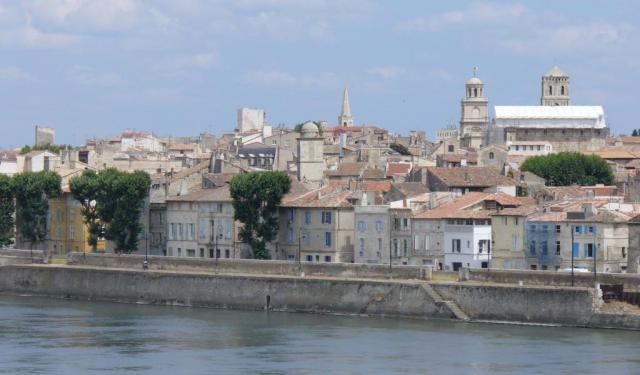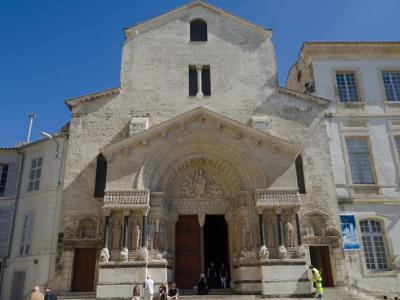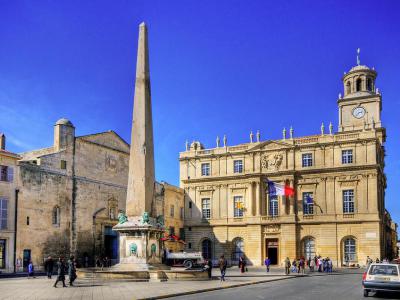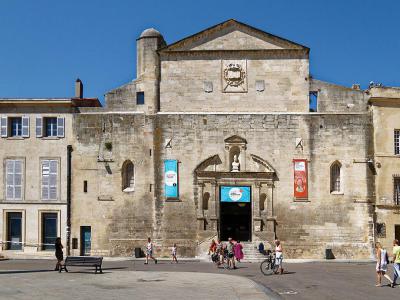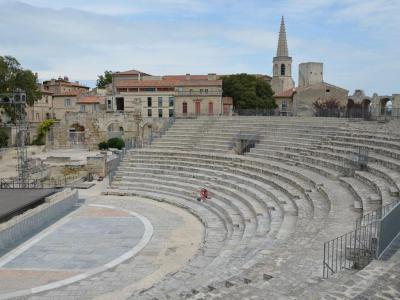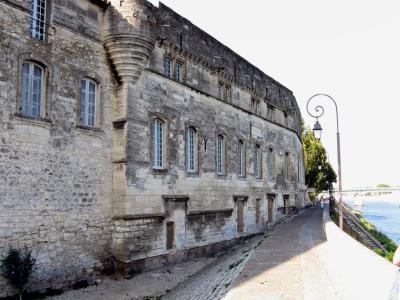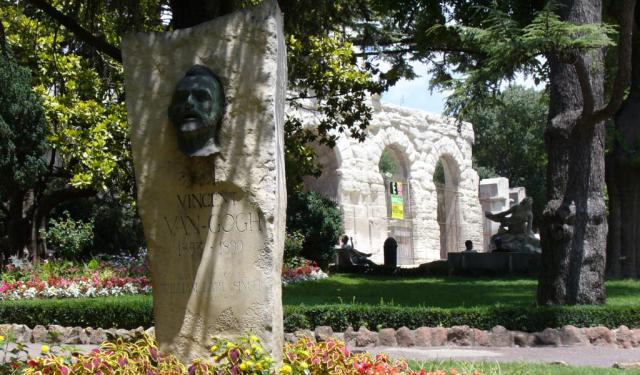Audio Guide: Arles Introduction Walking Tour (Self Guided), Arles
While living in Arles, Vincent van Gogh wrote to his brother Theo about the “soft and tender light” of the region. Although he called the town home for only 15 months, this brief period became the most productive of his career, yielding more than 300 works.
The town’s name comes from the ancient Ligurian and Celtic term Arelate, meaning “the dwelling by the marshes,” a nod to its fertile surroundings and proximity to the wetlands of the Camargue region.
The story of Arles begins around 800 BC, when the Ligurians first settled in the area. The Phoenicians later established a trading port, recognizing its strategic position between the sea and inland trade routes. The Greeks from nearby Marseille followed, further shaping its early prosperity.
Yet, Arles truly rose to prominence under Roman rule. In 123 BC, it became part of the Roman Empire, and a century later, Julius Caesar rewarded the city for its loyalty during his conflict with bitter rival Pompey by transforming it into a Roman colony — Arelate Julia. This ushered in its golden age as a thriving provincial capital and naval base, rivaling Marseille. Given the latter's punishment for standing with Pompey, Arles overtook Marseille in influence between the 4th and 5th centuries AD.
After Rome’s decline, Arles did not fall into anonymity, it adapted. Following a succession of rulers, the Holy Roman Empire knocked at the door in 1032. This event allowed the town to maintain its status throughout the Middle Ages.
A stroll through Arles’ old town reveals a tapestry of history and art — Roman ruins, narrow cobblestone streets, and vibrant Provençal cafés. The majestic Amphitheatre and Roman Theatre stand as reminders of the city’s imperial past, while the St. Trophime Church reveals medieval religious change. Brightly colored shutters, market scents, and echoes of Van Gogh’s paintings create an atmosphere where ancient Rome and artistic Provence meet under the Mediterranean sun.
Arles has been continuously inhabited for over 2,500 years, yet Van Gogh’s brief 15-month stay has become one of its proudest moments. The city celebrates its renowned resident, and as you begin this walk, you may find the same “soft and tender” light creeping out of every corner.
The town’s name comes from the ancient Ligurian and Celtic term Arelate, meaning “the dwelling by the marshes,” a nod to its fertile surroundings and proximity to the wetlands of the Camargue region.
The story of Arles begins around 800 BC, when the Ligurians first settled in the area. The Phoenicians later established a trading port, recognizing its strategic position between the sea and inland trade routes. The Greeks from nearby Marseille followed, further shaping its early prosperity.
Yet, Arles truly rose to prominence under Roman rule. In 123 BC, it became part of the Roman Empire, and a century later, Julius Caesar rewarded the city for its loyalty during his conflict with bitter rival Pompey by transforming it into a Roman colony — Arelate Julia. This ushered in its golden age as a thriving provincial capital and naval base, rivaling Marseille. Given the latter's punishment for standing with Pompey, Arles overtook Marseille in influence between the 4th and 5th centuries AD.
After Rome’s decline, Arles did not fall into anonymity, it adapted. Following a succession of rulers, the Holy Roman Empire knocked at the door in 1032. This event allowed the town to maintain its status throughout the Middle Ages.
A stroll through Arles’ old town reveals a tapestry of history and art — Roman ruins, narrow cobblestone streets, and vibrant Provençal cafés. The majestic Amphitheatre and Roman Theatre stand as reminders of the city’s imperial past, while the St. Trophime Church reveals medieval religious change. Brightly colored shutters, market scents, and echoes of Van Gogh’s paintings create an atmosphere where ancient Rome and artistic Provence meet under the Mediterranean sun.
Arles has been continuously inhabited for over 2,500 years, yet Van Gogh’s brief 15-month stay has become one of its proudest moments. The city celebrates its renowned resident, and as you begin this walk, you may find the same “soft and tender” light creeping out of every corner.
How it works: Download the app "GPSmyCity: Walks in 1K+ Cities" from Apple App Store or Google Play Store to your mobile phone or tablet. The app turns your mobile device into a personal tour guide and its built-in GPS navigation functions guide you from one tour stop to next. The app works offline, so no data plan is needed when traveling abroad.
Arles Introduction Walking Tour Map
Guide Name: Arles Introduction Walking Tour
Guide Location: France » Arles (See other walking tours in Arles)
Guide Type: Self-guided Walking Tour (Sightseeing)
# of Attractions: 12
Tour Duration: 1 Hour(s)
Travel Distance: 1.3 Km or 0.8 Miles
Author: DanaOffice
Sight(s) Featured in This Guide:
Guide Location: France » Arles (See other walking tours in Arles)
Guide Type: Self-guided Walking Tour (Sightseeing)
# of Attractions: 12
Tour Duration: 1 Hour(s)
Travel Distance: 1.3 Km or 0.8 Miles
Author: DanaOffice
Sight(s) Featured in This Guide:
- Place de la Republique (Republic Square)
- Obelisque d'Arles (Arles Obelisk)
- Cloitre Saint-Trophime (St. Trophime Cloister)
- Cathedrale Saint-Trophime d'Arles (St. Trophime Cathedral)
- Town Hall and Cryptoportics of Arles
- Eglise Sainte-Anne d'Arles (Arles St. Anne Church)
- Theatre Antique d'Arles (Ancient Theater of Arles)
- Arenes d'Arles (Arles Amphitheatre)
- Musee Reattu (Reattu Museum)
- Thermes de Constantin (Baths of Constantine)
- Place du Forum (Forum Square)
- Rue de la Republique (Republic Street)
1) Place de la Republique (Republic Square)
Republic Square serves as the city’s elegant and historic centerpiece. Paved with cobblestones and framed by impressive architecture, the square beautifully reflects Arles’s layered past.
At its center rises the Arles Obelisk, a 4th-century Roman obelisk that once adorned the ancient circus, rediscovered in the 17th century and erected here in 1676 to celebrate the city’s classical heritage. Around it stand several of Arles’s most remarkable landmarks: the Town Hall, built in the 17th century with a harmonious façade exemplifying Provençal classicism, and the Church of Saint Trophime, a Romanesque masterpiece famed for its sculpted portal depicting the Last Judgment and for being a key stop along the pilgrimage route to Santiago de Compostela.
Republic Square is not only a historic setting but also a vibrant part of daily life in Arles — a gathering place for residents, a venue for open-air markets, and a stage for local festivals beneath the Provençal sun. Visitors can enjoy the lively atmosphere from the surrounding cafés or admire the square as it glows in warm, golden tones. The golden hues of the architecture framing the square contribute to the election of the „Queen of Arles”. Every few years, a young woman is chosen to represent the traditions and customs of the region, all under the applause of crowds gathered in the Republic Square.
At its center rises the Arles Obelisk, a 4th-century Roman obelisk that once adorned the ancient circus, rediscovered in the 17th century and erected here in 1676 to celebrate the city’s classical heritage. Around it stand several of Arles’s most remarkable landmarks: the Town Hall, built in the 17th century with a harmonious façade exemplifying Provençal classicism, and the Church of Saint Trophime, a Romanesque masterpiece famed for its sculpted portal depicting the Last Judgment and for being a key stop along the pilgrimage route to Santiago de Compostela.
Republic Square is not only a historic setting but also a vibrant part of daily life in Arles — a gathering place for residents, a venue for open-air markets, and a stage for local festivals beneath the Provençal sun. Visitors can enjoy the lively atmosphere from the surrounding cafés or admire the square as it glows in warm, golden tones. The golden hues of the architecture framing the square contribute to the election of the „Queen of Arles”. Every few years, a young woman is chosen to represent the traditions and customs of the region, all under the applause of crowds gathered in the Republic Square.
2) Obelisque d'Arles (Arles Obelisk)
The Arles Obelisk stands proudly at the center of Republic Square, serving as one of the city’s most iconic landmarks and a testament to its Roman heritage. Carved from a single block of granite, the monument dates to the 4th century AD, when it originally adorned the Roman circus of Arles, a grand arena once used for chariot races. After the fall of the Roman Empire, the obelisk was lost to time, later rediscovered in fragments during the 17th century and re-erected in 1676.
The monument’s reinstallation marked a civic celebration of Arles’s ancient past, at a time when the city sought to reconnect with its classical roots. A gilded sun once crowned the obelisk, reflecting the light of Provence, though it has since been replaced by a bronze globe and later a weather vane. Standing over 20 meters tall, it commands attention amid the harmonious surroundings of Republic Square, flanked by the City Hall and Saint Trophime Church. Interestingly, unlike other Roman monuments, the obelisk lacks inscriptions.
Given it has been recognized as a historic monument since 1840, the obelisk has seen countless dawns and dusks. Yet, watching it shine in the center of the Republic Square remains an experience to be enjoyed. Cherry on top, it is on the UNESCO World Heritage list of Roman and Romanesque monuments since 1981.
The monument’s reinstallation marked a civic celebration of Arles’s ancient past, at a time when the city sought to reconnect with its classical roots. A gilded sun once crowned the obelisk, reflecting the light of Provence, though it has since been replaced by a bronze globe and later a weather vane. Standing over 20 meters tall, it commands attention amid the harmonious surroundings of Republic Square, flanked by the City Hall and Saint Trophime Church. Interestingly, unlike other Roman monuments, the obelisk lacks inscriptions.
Given it has been recognized as a historic monument since 1840, the obelisk has seen countless dawns and dusks. Yet, watching it shine in the center of the Republic Square remains an experience to be enjoyed. Cherry on top, it is on the UNESCO World Heritage list of Roman and Romanesque monuments since 1981.
3) Cloitre Saint-Trophime (St. Trophime Cloister) (must see)
The Cloister of Saint Trophime in Arles is one of the finest examples of Romanesque and early Gothic architecture in southern France, offering visitors a peaceful retreat steeped in art and spirituality. Built between the 12th and 14th centuries, it adjoins the Church of Saint Trophime, which was once the cathedral of Arles. The cloister served as the residence and contemplative space for the cathedral’s canons, providing a serene environment for prayer, study, and reflection.
What makes the Saint Trophime Cloister particularly exceptional is its remarkable sculptural decoration. Each gallery is adorned with intricately carved capitals and reliefs depicting biblical narratives, saints, and symbolic motifs that illustrate the transition from Romanesque to Gothic art. Visitors can observe this evolution firsthand: the older northern and eastern galleries feature rounded Romanesque arches, while the later southern and western galleries display the pointed arches characteristic of the Gothic style.
Unusually, the cloister connects to the church’s choir by a staircase of twenty-five steps — a rare arrangement, as cloisters are typically accessed from the nave or transept. Despite this distinctive layout, the cloister’s significance has long been recognized: it was designated a historic monument in 1846 and, like the Arles Obelisk, was inscribed on the UNESCO World Heritage list in 1981.
Beyond its artistic beauty, the cloister holds deep historical resonance. It was here that ecclesiastical councils were held and important decisions shaping the city’s spiritual life were made. Today, the site exudes an atmosphere of timeless calm, perfect for its meditative purposes. Go ahead and feel the silence yourself, but everyone has to work for it. Those steps will not climb themselves.
What makes the Saint Trophime Cloister particularly exceptional is its remarkable sculptural decoration. Each gallery is adorned with intricately carved capitals and reliefs depicting biblical narratives, saints, and symbolic motifs that illustrate the transition from Romanesque to Gothic art. Visitors can observe this evolution firsthand: the older northern and eastern galleries feature rounded Romanesque arches, while the later southern and western galleries display the pointed arches characteristic of the Gothic style.
Unusually, the cloister connects to the church’s choir by a staircase of twenty-five steps — a rare arrangement, as cloisters are typically accessed from the nave or transept. Despite this distinctive layout, the cloister’s significance has long been recognized: it was designated a historic monument in 1846 and, like the Arles Obelisk, was inscribed on the UNESCO World Heritage list in 1981.
Beyond its artistic beauty, the cloister holds deep historical resonance. It was here that ecclesiastical councils were held and important decisions shaping the city’s spiritual life were made. Today, the site exudes an atmosphere of timeless calm, perfect for its meditative purposes. Go ahead and feel the silence yourself, but everyone has to work for it. Those steps will not climb themselves.
4) Cathedrale Saint-Trophime d'Arles (St. Trophime Cathedral) (must see)
The Cathedral of Saint Trophime in Arles is one of the greatest masterpieces of Romanesque architecture in Provence and a highlight for any visitor to the city. Dedicated to Saint Trophimus, the first bishop of Arles and a key figure in the Christianization of the Gauls, the cathedral was built between the 12th and 15th centuries on the site of an earlier church. For centuries, it served as the seat of the archbishops of Arles and as an important stop along the pilgrimage route to Santiago de Compostela, contributing significantly to its artistic and religious prominence.
The main historical event connected to the Cathedral is the coronation of Holy Roman Emperor Frederick Barbarossa as king of Burgundy in 1178. Back then, it was a strategical move, as the newly crowned king was looking to consolidate his position following a series of defeats to the Lombard League.
The most celebrated feature of Saint Trophime is its magnificent Romanesque portal, sculpted around 1180. The façade depicts the Last Judgment, with Christ in Majesty surrounded by apostles, angels, and symbolic creatures — a stunning display of medieval craftsmanship. The detailed carvings make the portal one of the finest in France.
Inside, the cathedral’s austere Romanesque nave gives way to Gothic additions made in later centuries, creating a harmonious blend of styles. The church also holds a rich history of ecclesiastical councils, royal visits, and religious ceremonies that reflect Arles’s influence as a spiritual center during the Middle Ages.
For visitors today, Saint Trophime offers more than architectural beauty — it provides a window into the medieval soul of Arles. Customary to Arles's monuments, the Cathedral was listed as a UNESCO World Heritage Site in 1981.
The main historical event connected to the Cathedral is the coronation of Holy Roman Emperor Frederick Barbarossa as king of Burgundy in 1178. Back then, it was a strategical move, as the newly crowned king was looking to consolidate his position following a series of defeats to the Lombard League.
The most celebrated feature of Saint Trophime is its magnificent Romanesque portal, sculpted around 1180. The façade depicts the Last Judgment, with Christ in Majesty surrounded by apostles, angels, and symbolic creatures — a stunning display of medieval craftsmanship. The detailed carvings make the portal one of the finest in France.
Inside, the cathedral’s austere Romanesque nave gives way to Gothic additions made in later centuries, creating a harmonious blend of styles. The church also holds a rich history of ecclesiastical councils, royal visits, and religious ceremonies that reflect Arles’s influence as a spiritual center during the Middle Ages.
For visitors today, Saint Trophime offers more than architectural beauty — it provides a window into the medieval soul of Arles. Customary to Arles's monuments, the Cathedral was listed as a UNESCO World Heritage Site in 1981.
5) Town Hall and Cryptoportics of Arles
The Town Hall was completed in 1676, during a period when Arles sought to reaffirm its civic prestige. Designed in an elegant Provençal classical style, its harmonious façade and well-proportioned clock tower stand proudly on Republic Square, symbolizing the authority of the city’s magistrates.
Inside, its grand staircase is crafted using stones recovered from ancient Roman buildings. As a stylish bonus, the staircase also features a replica of Venus of Arles. The original ancient Greco-Roman sculpture was deemed to be a great gift for King Louis XIV, hence it was moved to the Versailles Palace itself.
Directly beneath Republic Square and the Town Hall lies the Cryptoporticus of Arles. Constructed around 30 BC during the Roman colony’s early development, this network of semi-subterranean vaulted galleries once supported the ancient forum above. The structure likely served multiple roles, including storage, administrative functions, and stabilization of the civic center built on uneven terrain. Remarkably well preserved, its long corridors, robust stone arches, and cool, shadowed atmosphere offer visitors a rare opportunity to explore the hidden infrastructure of a Roman city.
The contrast between the Town Hall’s sunlight-washed façade and the shadowed maze below it captures the pleasing dichotomy of Arles. Together, they reveal how the city’s history lives both above and beneath the surface — and whichever one you choose to discover first, both are ready to impress.
Inside, its grand staircase is crafted using stones recovered from ancient Roman buildings. As a stylish bonus, the staircase also features a replica of Venus of Arles. The original ancient Greco-Roman sculpture was deemed to be a great gift for King Louis XIV, hence it was moved to the Versailles Palace itself.
Directly beneath Republic Square and the Town Hall lies the Cryptoporticus of Arles. Constructed around 30 BC during the Roman colony’s early development, this network of semi-subterranean vaulted galleries once supported the ancient forum above. The structure likely served multiple roles, including storage, administrative functions, and stabilization of the civic center built on uneven terrain. Remarkably well preserved, its long corridors, robust stone arches, and cool, shadowed atmosphere offer visitors a rare opportunity to explore the hidden infrastructure of a Roman city.
The contrast between the Town Hall’s sunlight-washed façade and the shadowed maze below it captures the pleasing dichotomy of Arles. Together, they reveal how the city’s history lives both above and beneath the surface — and whichever one you choose to discover first, both are ready to impress.
6) Eglise Sainte-Anne d'Arles (Arles St. Anne Church)
Originally constructed in the 12th century as the Church of Notre-Dame-la-Principale, The Church of Saint Anne once served as a parish church closely linked to the neighbouring cathedral. Over time, its role shifted dramatically. In the 17th century, the building was repurposed as a seminary, later becoming a burial site for prominent canons of Saint Trophime.
It was also during the 17th century that the church received its current name. Consecrated on the feast day of Saint Anne, the dedication was far from coincidental: the church once safeguarded revered relics of Saint Anne, including a vermeil bust.
Although no longer functioning as a church, Saint Anne retains its solemn Romanesque character. The simplicity of its façade and the solid lines of its architecture bring back ideas of medieval craftsmanship.
Nowadays, Saint Anne is best known as a temporary exhibition space, hosting rotating displays of art and archaeology that complement Arles’s cultural scene. Even though the church retired from its original purpose, the value it provides to local history and culture cannot be understated. After all, it has not been granted the status of historical monument in 1875 for nothing.
It was also during the 17th century that the church received its current name. Consecrated on the feast day of Saint Anne, the dedication was far from coincidental: the church once safeguarded revered relics of Saint Anne, including a vermeil bust.
Although no longer functioning as a church, Saint Anne retains its solemn Romanesque character. The simplicity of its façade and the solid lines of its architecture bring back ideas of medieval craftsmanship.
Nowadays, Saint Anne is best known as a temporary exhibition space, hosting rotating displays of art and archaeology that complement Arles’s cultural scene. Even though the church retired from its original purpose, the value it provides to local history and culture cannot be understated. After all, it has not been granted the status of historical monument in 1875 for nothing.
7) Theatre Antique d'Arles (Ancient Theater of Arles) (must see)
The Ancient Theater of Arles stands as one of the earliest monumental structures built in the city following its Roman colonization, around the late 1st century BC under Emperor Augustus. Designed to showcase drama, poetry, and public entertainment, the theatre could once welcome more than 8,000 spectators who gathered to enjoy performances celebrating Roman culture and civic unity. Although much of its original grandeur has faded over the centuries, the structure remains an essential reminder of Arles’s role as a thriving provincial center in the Roman Empire.
Like many ancient sites, the theatre suffered significant dismantling during the Middle Ages, when its stones were reused to construct churches and fortifications. Even so, several remarkable features endure, including the remnants of the seating area and the circular orchestra in front of the stage. The latter still bears traces of an altar dedicated to Apollo — adorned with swans, the emblem of Emperor Augustus — which once occupied its center.
However, the most alluring of elements is a pair of elegant marble columns still standing behind the stage — a stunning fragment of what was once a richly decorated stage backdrop. These columns became known as the “Two Widows,” much like two wives awaiting their lost husbands.
Today, the Ancient Theater blends heritage with living culture. From the end of June to the end of August, it hosts the Arles and Costume Festivals, the International Photography Meetings and the Peplum Film Festival. You are more than welcome to enjoy them just like the Romans once did — under the open Provençal sky.
Like many ancient sites, the theatre suffered significant dismantling during the Middle Ages, when its stones were reused to construct churches and fortifications. Even so, several remarkable features endure, including the remnants of the seating area and the circular orchestra in front of the stage. The latter still bears traces of an altar dedicated to Apollo — adorned with swans, the emblem of Emperor Augustus — which once occupied its center.
However, the most alluring of elements is a pair of elegant marble columns still standing behind the stage — a stunning fragment of what was once a richly decorated stage backdrop. These columns became known as the “Two Widows,” much like two wives awaiting their lost husbands.
Today, the Ancient Theater blends heritage with living culture. From the end of June to the end of August, it hosts the Arles and Costume Festivals, the International Photography Meetings and the Peplum Film Festival. You are more than welcome to enjoy them just like the Romans once did — under the open Provençal sky.
8) Arenes d'Arles (Arles Amphitheatre) (must see)
The Arles Amphitheatre is one of the most impressive Roman monuments in southern France and a powerful symbol of the city’s ancient past. Built around 90 AD during the reign of Emperor Domitian, it was designed as a grand arena for gladiatorial games and public spectacles that entertained the population of Roman Arles, then known as Arelate. With an elliptical shape stretching over 130 meters in length and seating for more than 20,000 spectators, the amphitheatre reflected the city’s status and prosperity within the Roman Empire.
Over the centuries, its role changed significantly. Following the fall of Rome, the amphitheatre was fortified and transformed into a small defensive town complete with homes, shops, and even two chapels built within its walls. By the Middle Ages, more than 200 houses filled the interior, creating a bustling community protected by the original Roman towers. It was only in the 19th century, thanks to the efforts of preservationists including the writer Prosper Mérimée, that the houses were removed and restoration began to reclaim the monument’s ancient form.
Those restauration efforts were not in vain, as the arena still enthralls audiences with bullfighting events, plays and concerts to this day. Moreover, its stairways and upper tiers double as panoramic platforms which allow for prefect views of the city’s rooftops, the Rhône River, and the distant Alpilles hills. Fair enough — its inscription on the UNESCO World Heritage List in 1981 is more than deserved.
Over the centuries, its role changed significantly. Following the fall of Rome, the amphitheatre was fortified and transformed into a small defensive town complete with homes, shops, and even two chapels built within its walls. By the Middle Ages, more than 200 houses filled the interior, creating a bustling community protected by the original Roman towers. It was only in the 19th century, thanks to the efforts of preservationists including the writer Prosper Mérimée, that the houses were removed and restoration began to reclaim the monument’s ancient form.
Those restauration efforts were not in vain, as the arena still enthralls audiences with bullfighting events, plays and concerts to this day. Moreover, its stairways and upper tiers double as panoramic platforms which allow for prefect views of the city’s rooftops, the Rhône River, and the distant Alpilles hills. Fair enough — its inscription on the UNESCO World Heritage List in 1981 is more than deserved.
9) Musee Reattu (Reattu Museum)
The Reattu Museum in Arles offers an engaging blend of fine art, local heritage, and modern creativity within a historic riverside setting. Its origins trace back to the late 18th century when Jacques Réattu, a prominent Arles-born painter and Grand Prix de Rome laureate, acquired the former Commandery of the Knights of Malta and transformed part of the building into his residence and studio. After his death in 1833, the property and his artistic collection remained in the family until the mid-20th century, when the City of Arles purchased the estate and opened the museum in 1965, turning Réattu’s legacy into a cornerstone of local cultural identity.
The museum’s permanent collection includes more than 800 of Réattu’s paintings and drawings, reflecting the classical and romantic influences of his era. What makes the museum particularly compelling, however, is its strong commitment to contemporary art. In the 1960s, it became one of the first museums in France to recognize photography as a fine art, establishing an important collection that now features many notable contributors to the city’s renowned photography festival. By 2001, the photography collection had grown to around 4,000 works.
The museum also displays a set of original works donated by Pablo Picasso, who expressed his fondness for Arles — the city that had once inspired Van Gogh — by sending drawings and ceramics to support the museum’s growth.
The building itself adds an additional layer of fascination. The former knightly fortress, with its thick stone walls, vaulted halls, and views of the Rhône, adds a sense of historic character to the artistic experience. Sculptures, multimedia installations, and rotating exhibitions further animate the museum’s interior courtyard and galleries, making each visit unique.
The museum’s permanent collection includes more than 800 of Réattu’s paintings and drawings, reflecting the classical and romantic influences of his era. What makes the museum particularly compelling, however, is its strong commitment to contemporary art. In the 1960s, it became one of the first museums in France to recognize photography as a fine art, establishing an important collection that now features many notable contributors to the city’s renowned photography festival. By 2001, the photography collection had grown to around 4,000 works.
The museum also displays a set of original works donated by Pablo Picasso, who expressed his fondness for Arles — the city that had once inspired Van Gogh — by sending drawings and ceramics to support the museum’s growth.
The building itself adds an additional layer of fascination. The former knightly fortress, with its thick stone walls, vaulted halls, and views of the Rhône, adds a sense of historic character to the artistic experience. Sculptures, multimedia installations, and rotating exhibitions further animate the museum’s interior courtyard and galleries, making each visit unique.
10) Thermes de Constantin (Baths of Constantine)
The Baths of Constantine are a remarkable testament to Roman engineering and everyday life in the ancient city. Built in the early 4th century AD during the reign of Emperor Constantine the Great, they formed part of a larger palatial complex overlooking the Rhône and served as a place where citizens could enjoy bathing, relaxation, and social interaction — a staple of Roman urban culture. Although only a portion of the baths survives today, what remains offers a vivid impression of their original scale and function.
The best-preserved section includes the caldarium, or hot room, recognizable by its thick walls and semi-domed architecture that once supported an elaborate heating system known as the hypocaust, which circulated warm air beneath the floors. Fragments representing the frigidarium and tepidarium — the cold and warm rooms — recall the ritual progression of Roman bathing. The brick arches, vaulted ceilings, and traces of marble decoration highlight the sophistication of Arles as a Roman colony and the comfort and luxury that bathers could enjoy nearly 1,700 years ago.
Over time, the structure endured damage and alterations, particularly in the Middle Ages when the surrounding area was fortified. Yet its core remained intact, earning recognition as a historic monument as early as the 19th century. Thanks to this resilience, the Baths of Constantine are among the best-preserved Roman baths in France, alongside the renowned Baths of Cluny in Paris.
The best-preserved section includes the caldarium, or hot room, recognizable by its thick walls and semi-domed architecture that once supported an elaborate heating system known as the hypocaust, which circulated warm air beneath the floors. Fragments representing the frigidarium and tepidarium — the cold and warm rooms — recall the ritual progression of Roman bathing. The brick arches, vaulted ceilings, and traces of marble decoration highlight the sophistication of Arles as a Roman colony and the comfort and luxury that bathers could enjoy nearly 1,700 years ago.
Over time, the structure endured damage and alterations, particularly in the Middle Ages when the surrounding area was fortified. Yet its core remained intact, earning recognition as a historic monument as early as the 19th century. Thanks to this resilience, the Baths of Constantine are among the best-preserved Roman baths in France, alongside the renowned Baths of Cluny in Paris.
11) Place du Forum (Forum Square)
Forum Square stands on the site of what was once the vibrant political and commercial heart of the Roman city of Arelate. Established in the 1st century BC during the urban expansion under Emperor Augustus, the Roman forum served as a grand public space lined with temples, administrative buildings, and arcades where citizens gathered to debate politics, conduct business, and participate in public life. Although the ancient structures have mostly disappeared beneath centuries of urban development, the square remains an important reference point for understanding the early formation of Arles.
Today, Forum Square preserves only a small but striking architectural fragment from its Roman past: the “Two Columns.” These Corinthian shafts, built into the corner of a later building, provide a reminder of a former temple dedicated to the Roman Emperor Augustus. Their weathered surfaces contrast with the lively cafés and restaurants that now animate the square, particularly in summer, when terraces spill out beneath the Provençal sun.
Nearby, charming narrow streets lead visitors deeper into the Old Town, emulating the compact street plan established during the Roman period. The square also carries cultural significance through its association with artists such as Vincent van Gogh, who painted scenes of the neighborhood during his time in Arles.
Forum Square continues to serve as a social hub — a place where locals meet, visitors pause, and the history of Arles quietly supports the life unfolding above it. Put on your Provence glasses and you might witness the hayday of this lively square.
Today, Forum Square preserves only a small but striking architectural fragment from its Roman past: the “Two Columns.” These Corinthian shafts, built into the corner of a later building, provide a reminder of a former temple dedicated to the Roman Emperor Augustus. Their weathered surfaces contrast with the lively cafés and restaurants that now animate the square, particularly in summer, when terraces spill out beneath the Provençal sun.
Nearby, charming narrow streets lead visitors deeper into the Old Town, emulating the compact street plan established during the Roman period. The square also carries cultural significance through its association with artists such as Vincent van Gogh, who painted scenes of the neighborhood during his time in Arles.
Forum Square continues to serve as a social hub — a place where locals meet, visitors pause, and the history of Arles quietly supports the life unfolding above it. Put on your Provence glasses and you might witness the hayday of this lively square.
12) Rue de la Republique (Republic Street)
Republic Street is one of the principal thoroughfares in Arles and a natural route for anyone exploring the heart of the city. Its origins align with 19th-century urban modernization, when Arles redesigned parts of its medieval street network to create a grander, more functional promenade leading directly to Republic Square. The wide, straight layout contrasts with the surrounding maze of narrow historic alleys.
Today, Republic Street plays an important role as a commercial and cultural artery. Lined with shops, cafés, bookshops, and boutiques, it offers a pleasant environment for a leisurely stroll or a shopping break between visits to nearby landmarks such as the Town Hall, Saint Trophime, and the Reattu Museum. The street also features handsome 19th-century façades and subtle architectural details that highlight Arles’s evolution from an ancient Roman colony into a modern Provençal city.
As visitors walk along this lively avenue, they experience a constant blend of everyday local life and the artistic atmosphere that Arles is known for. Get guided by the wafting aromas of fresh bread and pastries and you will surely love the main artery of Arles.
Today, Republic Street plays an important role as a commercial and cultural artery. Lined with shops, cafés, bookshops, and boutiques, it offers a pleasant environment for a leisurely stroll or a shopping break between visits to nearby landmarks such as the Town Hall, Saint Trophime, and the Reattu Museum. The street also features handsome 19th-century façades and subtle architectural details that highlight Arles’s evolution from an ancient Roman colony into a modern Provençal city.
As visitors walk along this lively avenue, they experience a constant blend of everyday local life and the artistic atmosphere that Arles is known for. Get guided by the wafting aromas of fresh bread and pastries and you will surely love the main artery of Arles.
Walking Tours in Arles, France
Create Your Own Walk in Arles
Creating your own self-guided walk in Arles is easy and fun. Choose the city attractions that you want to see and a walk route map will be created just for you. You can even set your hotel as the start point of the walk.
Vincent van Gogh Walking Tour
"There's no place quite like it for painters. It's so beautiful and peaceful..." These words, reportedly attributed to Vincent van Gogh, emphasize the beauty and exceptional qualities of Arles with which the renowned Dutch painter had a special connection.
Vincent van Gogh moved to this town in 1888, after having worked in Paris for two years. In the late 19th century,... view more
Tour Duration: 1 Hour(s)
Travel Distance: 2.1 Km or 1.3 Miles
Vincent van Gogh moved to this town in 1888, after having worked in Paris for two years. In the late 19th century,... view more
Tour Duration: 1 Hour(s)
Travel Distance: 2.1 Km or 1.3 Miles
The Most Popular Cities
/ view all
